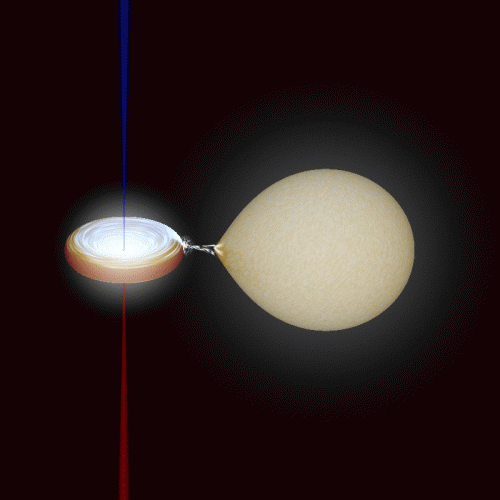A microquasar makes a giant Manatee Nebula

(Phys.org)—A new view of a 20,000-year old supernova remnant demonstrates the upgraded imaging power of the National Science Foundation's (NSF) Karl G. Jansky Very Large Array (VLA) and provides more clues to the history of this giant cloud that resembles a beloved endangered species, the Florida Manatee.
W50 is one of the largest supernova remnants ever viewed by the VLA. At nearly 700 light years across, it covers two degrees on the sky – that's the span of four full Moons!
Turbulent History
The enormous W50 cloud formed when a giant star, 18,000 light years away in the constellation of Aquila, exploded as a supernova around twenty thousand years ago, sending its outer gases flying outward in an expanding bubble.
The remaining, gravitationally-crushed relic of that giant star, most likely a black hole, feeds on gas from a very close, companion star. The cannibalized gas collects in a disk around the black hole. The disk and black hole's network of powerful magnetic field lines acts like an enormous railroad system to snag charged particles out of the disk and channel them outward in powerful jets traveling at nearly the speed of light. This system of a black hole and its feeder star shines brightly in both radio waves and X-rays and is known collectively as the SS433 microquasar.
Over time, the microquasar's jets have forced their way through the expanding gases of the W50 bubble, eventually punching bulges outward on either side. The jets also wobble, like an unstable spinning top, and blaze vivid corkscrew patterns across the inflating bulges.

New Namesake
Optically bright astronomical objects, those visible to the eye and optical telescopes, often are nicknamed for their earthly likenesses, such as the Whirlpool Galaxy and Owl Nebula. Invisible W50 comes by its less catchy name by being the 50th radio source listed in the Westerhout Catalog, assembled in 1958 by Dutch astronomer, Gart Westerhout.
When the VLA's giant W50 image reached the NRAO Director's office, Heidi Winter, the Director's Executive Assistant, saw the likeness to a manatee, the endangered marine mammals known as "sea cows" that congregate in warm waters in the southeastern United States.
Florida Manatees are gentle giants that average around 10 feet long, weigh over 1000 pounds, and spend up to eight hours a day grazing on sea plants. They occupy the remainder of their day resting, often on their backs with their flippers crossed over their large bellies, in a pose closely resembling W50.
Dangerous encounters with boat propellers injure many of these curious herbivores, giving them deep, curved scars similar in appearance to the arcs made by the powerful jets on the large W50 remnant.
Thanks to Ms. Winter's suggestion, the National Radio Astronomy Observatory has adopted a new nickname for W50: The Manatee Nebula. In collaboration with the U.S. Fish and Wildlife Service, the NRAO will unveil the Manatee Nebula to the public during the annual Manatee Festival in Crystal River, Florida on a stage overlooking the largest natural concentration of wintering manatees in the world.
Provided by National Radio Astronomy Observatory





















